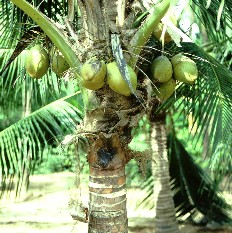Tree holds promise for future of biofuel
UH hopes to grow an isle biofuel source to re-engergize Hawaii's
agriculture industry
STORY SUMMARY »
Unused land on the Waianae Coast and other areas of the state could one
day be green with plants grown for fuel to reduce Hawaii's dependence on
imported oil.
That's the hope of researchers who are trying to determine if biofuel
crops have the potential to re-engergize Hawaii's agriculture industry.
The University of Hawaii and the Hawaii Agriculture Research Center are
growing test plots of jatropha, a plant that is already being used to
make biodiesel in India.
But what's yet to be determined is whether the crops will be profitable
for farmers.
STAR-BULLETIN
FULL STORY »
By Craig Gima / cgima@starbulletin.com
A patch of green trees rising from the red dirt at the University of
Hawaii's Poamoho Experimental Farm may be the first seedlings in what
could become a new agricultural industry in Hawaii -- growing crops for
fuel.
Jatropha trees are already grown to make biodiesel in India. The plants
have three pointed leaves like the kukui nut tree and when the fruit
ripens, it contains three seeds which are high in oil content.
UH researchers planted a test crop of jatropha trees in January and they
are already starting to bear fruit. A similar plot at the Hawaii
Agriculture Research Center in Kunia has also flowered and borne fruit.
Mike Poteet, a crop scientist with the Hawaii Agriculture Research
Center, believes biofuels have the potential to create a new agriculture
industry in Hawaii.
Poteet wrote a report last year that suggested Hawaii could grow enough
biodiesel crops to reduce imported diesel by 20 percent -- perhaps 150
million gallons a year.
But he said the effort is still in its infancy.
art3
RICHARD WALKER / RWALKER@STARBULLETIN.COM
Richard Ogoshi shows the tree's fruit. The oil in these seeds could be
used to produce biodiesel.
"Right now we're just crossing our fingers," Poteet said. But he said
the crops could have the potential to "revitalize agriculture across the
state."
Plans are already underway to build two large biodiesel plants in
Hawaii. A Seattle-based company, Imperium Renewables Inc., wants to
build a $90 million processing plant at Barbers Point to produce 100
million gallons of biodiesel a year.
Maui Electric Co. and BlueEarth Maui Biodiesel has also proposed a $61
million refinery on the Valley Isle to produce up to 120 million gallons
a year of biodiesel to produce electricity.
Both companies would start operations using imported vegetable oil. But
both also have said they would eventually like to use local crops.
"The market is there. We've got to do something to meet the demand,"
said Richard Ogoshi, a crop researcher at the College of Tropical
Agriculture at UH-Manoa.
But farmers won't risk growing a crop without knowing how best to raise
it and if they can make money.
It's hoped the research going on now will determine what crops might
work best in different growing conditions in Hawaii and what plants will
give farmers the best return.
"Until somebody shows it's feasible, it's going to be difficult for a
landowner to put his money into it, because it's such a gamble," said
Bill Steiner, dean of UH-Hilo's College of Agriculture, Forestry and
Natural Resources.
art3
RICHARD WALKER / RWALKER@ STARBULLETIN.COM
Jatropha fruit start off green and turn yellow as they mature.
JATROPHA TREE
» Native to Caribbean
» Seeds used in India to produce biodiesel
» Oil content: 43-59 percent
» Potential gallons of oil per acre: 300
» Grows in a variety of conditions and can withstand high temperatures
and drought.
Source: Biodiesel Crop Implementation in Hawaii report
Steiner is leading a UH-Hilo effort to begin research in growing
different types of oil palm on 120 acres of land in Pauuilo on the
Hamakua coast.
So far, Steiner has about $45,000 and is seeking more funding.
UH-Manoa and HARC are sharing a $150,000 state Department of Agriculture
grant. UH-Manoa also received another $250,000 from the Legislature this
year, said Goro Uehara, a soil scientist with the College of Tropical
Agriculture.
UH-Manoa is starting with jatropha because it has already been grown
successfully elsewhere. It also can be grown on marginal agricultural
land, Uehara said.
"We have to find crops that will grow in underutilized areas. We don't
want to compete with prime agriculture," Uehara said.
UH has identified plots of land on different islands with varying
conditions to plant jatropha and other potential fuel test crops
including kukui, castor bean, soy bean, sugar, sugar beet and sweet
potato. Scientists are also looking at haole koa and some varieties of
grass that could be used with cellulose-technology to make fuel.
Another part of the research is looking at byproducts from fuel plants
into other salable products, such as animal feed or pharmaceutical
products, Poteet said. The sap of the jatropha is similar to latex and
that may also have some value, he added.
"It could mean new jobs and new businesses," Steiner said. "It could be
very interesting for Hawaii besides leading us down a path towards more
energy independence."
The researchers emphasized that they are three to six years away from
being able to determine the economic viability of fuel crops in Hawaii
and the best ways to grow them.
"We are in the infant stages," Poteet said. "There's a very great
potential for this industry but we've got to have the support to get
things off the ground."
--
Check for earlier Pacific Biofuel posts: http://pacbiofuel.blogspot.com/

No comments:
Post a Comment